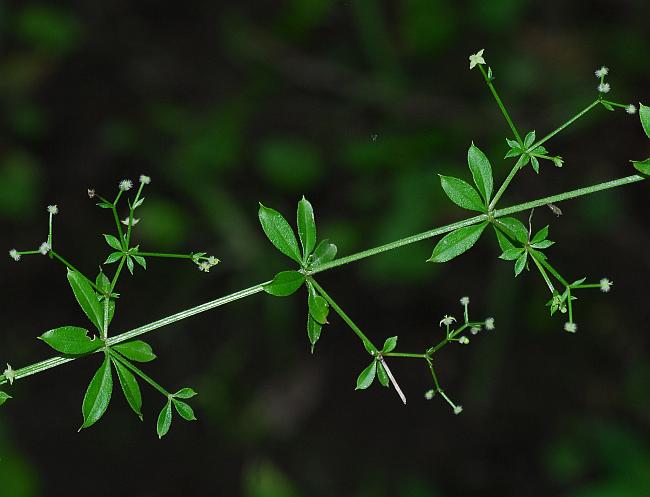Galium triflorum Michx.
Fragrant Bedstraw

Native
CC = 4
CW = 3
MOC = 70
© SRTurner
Galium triflorum Michx.Fragrant Bedstraw | |
 |
Native CC = 4 CW = 3 MOC = 70 |
© SRTurner |
|
Family - Rubiaceae Habit - Perennial forb. Stems - Spreading to weakly ascending or trailing on other vegetation, usually branched, 4-angled, glabrous or sparsely to moderately pubescent with short, spreading to downward-angled hairs on the angles.
Leaves - Whorled, simple, sessile, usually 6 per node, more or less spreading in orientation. Blades 5-35 mm long, 2-10 mm wide, narrowly elliptic to oblanceolate, rounded or angled to a bluntly pointed tip, the midvein extended into a short, sharp point, angled or tapered at the base, glabrous or sparsely roughened with minute, downward-angled, pricklelike hairs along the midvein, the venation with only a single midvein visible, the margins roughened with minute to short, stiff, ascending hairs, flat or slightly curled under.
Inflorescences - Terminal and usually also axillary from the upper leaves, not pendent, positioned over the leaves, usually consisting of small (1-5 cm long), stalked clusters or small panicles, with mostly 1-3 branch points. Flowers 3 to several, the stalks 1-6 mm long, becoming elongated to 10 mm at fruiting.
Flowers - Calyces essentially absent. Corollas 1.0-1.2 mm long, 4-lobed, white. Stamens 4, attached in the corolla tube, the anthers exserted. Style 2-lobed, the stigmas 2, capitate. Ovary with dense, hooked hairs, inferior, 2-locular, the ovules 1 per locule.
Fruits - Small dry schizocarps 1.5-2.5 mm long, 1.5-2.5 mm wide, the surface densely pubescent with hooked hairs ca. 0.8 mm long.
Flowering - May - September. Habitat - Bottomland and mesic forests, streambanks, pond margins, fens, pastures, old quarries, railroads, roadsides. Origin - Native to the U.S. Lookalikes - Other species of Galium, especially G. aparine. Other info. - This species can be found throughout Missouri and in every state in the continental U.S., and also ranges into Canada, Mexico, and other parts of the world. The plant can be identified by its whorl of 6 oblong-elliptic leaves per node and small white flowers with bristly ovaries. It is similar to, but less weedy than, the very common G. aparine, a plant which has more scabrous and clingy foliage. Photographs taken in Brown Summit, NC., 6-10-02 (DETenaglia); also at Shaw Nature Reserve, Franklin County, MO, 07-22-2019, and Meramec Conservation Area, Franklin County, MO, 7-14-2020 (SRTurner). |